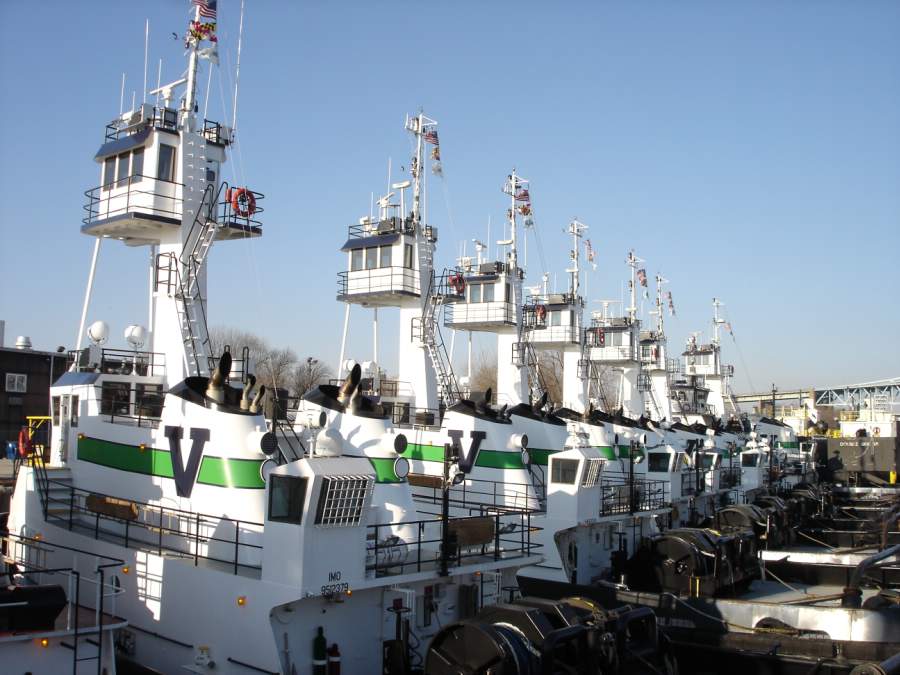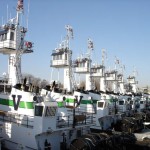If there is a credit crisis in Baltimore, it sure must have passed by the door of Vane Brothers on Frankfurst Ave.
 |
This century-old company has just completed a 15-boat new-building contract with Thoma-Sea Boat Builders of Louisiana, but it is only partway through an additional six-boat building contract with Chesapeake Shipbuilding of Maryland. And the company may not be done after that. While all this is going on, Vane Brothers has accepted deliveries of a flotilla of new barges from Trinity Industries and Jeffboat, while also accepting a pair of completed 140,000-barrel ATB units from Bay Shipbuilding in Wisconsin.
Sassafras and Elk River are the first two tugs in a series of six to be completed by Chesapeake Shipbuilding in the next year or two. They are 94-foot, 3,000 hp, Caterpillar-powered conventional twin-screw tugs designed to handle either a 30,000-bbl oil barge or one of the company’s larger 50,000-bbl barges. These tugs are designed to move barges up tributaries of Chesapeake Bay and into other near-coastal spots along the Eastern Seaboard. They are also intended for bunkering work in ports like Philadelphia and New York, and for near-coastal wire tows along the East Coast or beyond.
To some extent, Sassafras is just a scaled down version of the 15 Patapsco-class tugs built at the Thoma-Sea Shipyard in Houma, La., between 2004 and 2009. The last of those larger tugs, Anacostia and Severn, will be delivered in the first half of this year. Naval architect for all of these tugs, large and small, is Frank Basile of Entech & Associates, also in Houma, La. These tugs have nothing to do, of course, with the former 157-foot Patapsco-class U.S. Navy fleet tugs built prior to World War I. They are all named for Chesapeake Bay tributaries, except in different centuries.
Perhaps the most conspicuous difference between the Thoma-Sea-built tugs for Vane and those of Chesapeake Shipyard is the absence of a propeller nozzle on the Chesapeake tugs.
Nozzles were dropped to enhance maneuverability and to facilitate operations in shallow water, according to Jim Demske, port captain for this fast-growing mid-Atlantic company. “The Sassafras-class boats have nice heavy shoes and open wheels, plus we went with a larger rudder than was originally designed,” said Demske. As a result, he said, the new design has proved to be exceptionally good handling.
“If you are running in shoal areas, the nozzles tend to suck up everything within reach and pull it right into the water stream going through there,” Demske added. “Those nozzles are like big vacuum cleaners sucking everything right into them. We have also found that we get more maneuverability out of a boat without nozzles. You can walk barges alongside ships or walk them to the pier. It’s hard to do those things with a nozzle boat.”
Both tug versions are relatively low and muscular looking workboats with dual pilothouses, towing winches and towing bars stretched across their sterns. That green stripe with the big ‘V’ on the funnel casing makes them easy to identify.
It may be hard to discern this from a distance, but the company has made changes to the upper wheelhouse to enhance visibility and crew comfort, according to Demske. Pilothouse windows are taller on Sassafras and there are more opening windows, he said. Plus the forward windows are installed at a greater angle to enhance visibility while reducing reflection.
“The creature comforts up there are a little bit nicer,” said Demske.
 |
The big difference inside those windows of Sassafras, however, is installation of a complete NavNet 3D navigation package from Furuno. The company used a Simrad electronics package on its earlier line of new tugs, but since the introduction of NavNet 3D, Vane has gone completely Furuno.
“Furuno has been making great strides in this field,” he explained. “I wanted something for these newest tugs that was more of the cutting edge design, and these NavNet 3D displays are far superior to anything else I’ve seen in the trade lately.” All the electronics were furnished, supplied and custom installed by Rhodes Electronics of Houma, La.
Of course the new boats have slightly lower power ratings to go with their slightly smaller size. Propulsion comes from a pair of Cat 3512C diesels with Twin Disc 6:1 gear boxes. These are rated at 1,500 hp each. At the far end, Vane went with Troost-designed, 87-inch, Rolls-Royce propellers.
Something new on the aft deck is a single-drum towing winch supplied by JonRie InterTech of New Jersey. The previous line of tugs employed towing winches from Intercon.
Doing the heavy hauling aboard Sassafras is a JonRie Series 500 hydraulic winch adjacent to a JonRie Series 421 hydraulic capstan. The winch, with line pull of 100,000 pounds and line speed of 60 feet per minute, is fitted with 1.75-inch wire rope.
Even as Vane Bros. continues to pump out new tugs from its contracted shipyards, the company is also still getting deliveries of new barges. As of this spring the company still had two 50,000-bbl oil barges under construction at Jeffboat in Indiana and six more 35,000-bbl barges in the works at Trinity Industries.
 |
| A highlight of wheelhouse electronics aboard Sassafras is the Furuno NavNet 3D charting system. |
“There are so many barges now, I’m having trouble keeping track of them,” commented Demske. He noted that there are probably only four or five single-skin barges left in the company fleet. Vane has plans to be operating an all double-hull fleet within a year or two. As of this spring, the company was operating a fleet of 47 barges with eight more still under construction. Vane’s tug fleet has also grown dramatically in recent years. As of June, Vane was operating 33 tugs with four more yet to be delivered.
“Make that ‘at least’ four more yet to be delivered,” said Demske. “We still have options for a couple more and there are all kinds of plans for the future around here that people want to talk about.”
Gregory M. Walsh
Original article: http://www.professionalmariner.com/December-January-2009/Vane-Nears-the-End-maybe-of-Building-Spree/

